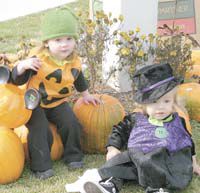| Dylan Stanley, Price and Ella Jones, Logan, are ready for Halloween. Carbon County residents steeped in the holiday tradition know to exercise special caution on the roads on the annual fright night. |
If donning a ghoul suit and trolling for candy has become a little too pass�, residents can try putting clothes on inside out and walking backwards Halloween night.
According to an ancient superstition, the act promises to produce the sight of a witch in the sky at midnight.
For a young single woman, fright night might bring Mr. Right if the lass puts some rosemary and a silver sixpence under her pillow.
| FRIGHTFUL FUN FACTSHalloween 2007 is here, below are some facts and figures about the spookiest day of the year.The term trick-or-treat was traced back to an Oct. 30, 1938 article printed in the Los Angeles Times that read, “Trick or treat is the hijacking game hundreds of Southern California youngsters will play tomorrow night.” � The History of Halloween The history of the Jack-o’-lantern is connected to an Irish myth about a man named “Stingy Jack” whose repeated deals with the devil, whom he tricked, kept him out of both heaven and hell after he died. Jack was sent off into the night with only a burning coal for light that he put into a carved-out turnip and to roam the earth eternally. � History.com |
The night, closely associated with cavities and belly aches, is actually steeped not only in superstition, but in history.
The holiday celebrated Oct. 31 by costumed revelers is rooted in the times of the Druids and in a part of the world that was not yet known as Ireland.
The ancient Celts celebrated their new year which began Nov.1 with a festival called Samhain.
It is believed that, during Samhain, the Druids, who are described as the elite and learned class of the ancient Celts, would build bonfires in which animals and crops were sacrificed.
According to an article by Pastor Dennis Rupert on www.new-life.net, the turning of the year from one to the next was the most magical of times for the Celts.
This was the time when the veil between worlds was the thinnest and the dead could communicate with the living.
According to several sources on the Internet, including History.com and Wikipedia, the Celts wore costumes of animal heads and skins.
However, the heads and skins are not cited as the birth of costuming on most research sites.
The practice of dressing up and going door-to-door appears to have sprung from poor people in England on All Soul’s Day who would beg for food from other residents.
According to History.com the beggars would receive what was called a “soul cake” for promising to pray for dead relatives of the person giving the pastry.
Wednesday night’s ghouls, goblins and ghosts prowling Carbon County, their candy sacks clutched tight in hand, are a far cry from pagans dancing about the fires in ancient Ireland. However, they are still connected to historically significant times, according to History.com.
The holiday of today evolved from the early days of this nation when colonials held Halloween fetes that incorporated ghost stories, fortune telling and “mischief-making.” By the turn of the century Halloween parties were the norm but the ghosties and ghoulies were extracted from the celebrations as parents were encouraged to take the fright out of fright night, according to History.com.
Trick-or-treating had been laid to rest for many decades and while revived in the roaring 20s, the tradition was still more akin to the early days of begging for food, according to Rupert’s article “The History of Halloween.”
By the 1950s however, the holiday as it is currently known appears to have been fully established. Today, Americans spend an estimated $6.9 billion annually on Halloween, making it the country’s second largest commercial holiday.
| Safe and Sane Halloween Tips While the right costume and the biggest candy sack are essentials for a fun Halloween night, there are some other elements that will also insure that it is also a safe night. Drivers • Should be especially alert in residential neighborhoods • Drive more slowly and anticipate heavy pedestrian traffic on and near roads • Be sure to use full headlights to better spot children at a distance • Actively look for kids at intersections, on medians and on curbs • Enter and exit driveways and alleys slowly and carefully • Keep in mind that the heaviest trick or treat times are during the hours of 5:30 p.m. to 9:30 p.m. • Reduce any distractions inside the car to be able to concentrate on the road and pedestrians Trick or Treaters • Should always trick-or-treat with an adult until age 10 • Only trick-or-treat in familiar areas that are well lit • Cross streets at corners using traffic signals and crosswalks • Look left, right and left again when crossing • Make eye contact with drivers always look for cars backing up • Walk on sidewalks or paths; if there are no sidewalks, walk facing traffic as far to the left as possible • Never dart out into the street or cross between parked cars • Wear light colored, flame-retardant, costumes decorated with retro-reflective tape or stickers • Wear well-fitting, sturdy shoes to prevent trips and falls • Carry a flashlight or glow stick to increase visibility to drivers • Wear face paint and makeup; a mask can restrict a child’s vision � Safe Kids/Fed Ex |
| cutline |

